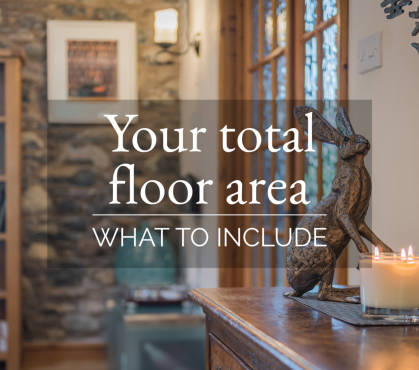Your Total Floor Area – What to Include
02/07/2019

More and more these days, the total floor area of a property is included on the floorplan, which can be very useful to a buyer when they are trying to work out how much house they are getting for their money. At Smith & Co. Estates, we compile a ‘Price per square foot analysis’ for our clients, so they can see how they compare with the competition. But what should you include, or exclude from the overall square footage total?
Well, it’s certainly not an exact science, and other industry professionals may have their own formula, but I thought I would share mine with you here, so you can decide for yourself.
Firstly, let’s look at what the figure actually means; when your floorplan is compiled, the floor area is calculated automatically by the software that was used to create it. This area is the gross internal floor area, which means, it is the total area within the external walls of the building, as if there were no inside walls. So corridors and wall thicknesses are included in this figure. If your property is a square or a rectangle, you may be able to calculate this figure yourself, by taking the outside footprint then deducting the external wall thicknesses (usually around 12” for a brick/cavity/block construction).
Next, let’s consider what should and shouldn’t be included in the overall figure. As a general rule of thumb, I include any area which is, or could, be used as residential accommodation; therefore I would include an internal garage, because these are usually constructed so they can be easily converted, but not a detached garage, which often isn’t. I wouldn’t include an inside swimming pool, whether or not attached to the house, but I would include an over-garage studio, which is extra accommodation. If there is a detached cottage in the grounds, I would include that separately, as it can often skew the results, and position it in the comparison table in two places, to see what effect it has. Cellars can be included if they are full head height (at least 7 feet), similarly with attics.
It is worth bearing in mind though, that not all square footage is equal: town houses, where the accommodation is spread over three or four floors, are not equal to bungalows, where the overall footprint of the house, and its plot, are much larger. There is no formula to take this into account, so when you compare your property to others for sale, try to pick similar styles of home to compare to.
What this exercise may highlight, is how much each room is worth to you: often a valuable insight in itself. For example, if your price per square foot is £300, and you have an unused bedroom or box room at 10’ by 10’ (100 square feet) it is actually worth £30,000 of your house price; if you don’t define its use for a buyer, they may well dismiss it, and as a consequence, your asking price will appear to be £30,000 overpriced. Multiply that by three rooms, and you’re potentially ‘wasting’ around £100,000!
So if you’d like to optimise every inch of your home, we’d love to help. Just call us on 01623 392352 or drop us a line at info@smithandcoestates.co.uk
Warm regards
Sara

